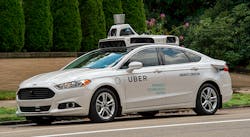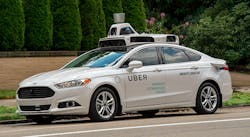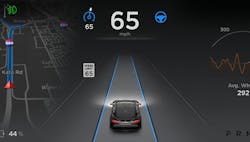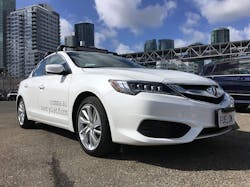Self-Driving Cars Are Coming Whether You Like It or Not
Sorry, Lou (Frenzel). We are not going to be able to forget this self-driving car nonsense (see “Forget this Self-Driving Car Nonsense” on electronicdesign.com). It is coming whether we like it or not. We can only hope that it winds up being safe enough to live with.
A couple of items have cropped up recently that highlight the trend. The first is Uber’s use of self-driving cars in a commercial setting. The second is the now familiar Tesla Autopilot. The third is comma.ai’s add-on autopilot.
Uber’s Pittsburgh Experiment
In this case, a fleet of self-driving cars is running in Pittsburgh (Fig. 1), albeit with standby drivers. In 2014, Uber set up the Advanced Technologies Center (ATC) in the city, making it an ideal place to run a trial of its self-driving car service.
Uber is not replacing its drivers in Pittsburgh yet, so if you call for a car you will probably not wind up with one of these self-driving platforms. It will be using the cars for a select few in the downtown and Strip District of Pittsburgh. It will give Uber’s engineers hundreds of test miles to analyze.
Uber’s modified hybrid Ford Fusion is rather obvious, given the sensor suite mounted on the roof. It includes a collection of radar, laser scanner, and high-resolution cameras. The sensor suite delivers a massive amount of information to a computational system that Uber is keeping under wraps. It is running a range of software including artificial intelligence (AI) support that is likely to improve with more input (shades of Number 5 in the 1968 movie, Short Circuit). Neural network-based deep learning systems typically require a large collection of information for training (see “Is It Time to Learn About Deep Learning?” on electronicdesign.com).
The testing is occurring in the summertime when the weather tends to be the best. I suspect that winter weather, especially in Pittsburgh, will be a challenge that may not be attempted in the near term, although the area currently being used would have its roads cleared quickly and they are relatively flat compared to some of Pittsburgh’s other neighborhoods. Also, the area covered has more limited speed restrictions, well-marked roads, and a well-mapped layout.
Still, the results of Uber’s tests will be invaluable to developers. This is obviously just a first step in the direction of driverless vehicles.
Tesla Autopilot
Of course, Elon Musk’s Tesla (Fig. 2) Autopilot is readily available on somewhat costly vehicles. It does make sense though, as self-driving technology is not cheap and even the minimal requirements exceed any low or mid-range vehicle on the road today. That said, the standard engine control unit (ECU) and antilock-braking system that is standard these days would have been found only on high-end vehicles of the past.
Tesla’s offering tends to be more advanced than most, but many of its features, sensors (camera, radar, ultrasonic), and software (from a high level view) are the same as that found in competing high-end vehicles. This includes radar and camera sensors coupled with traffic-aware cruise control. A basic version of this cruise control simply adjusts the speed of the vehicle while more advanced versions can adjust the steering.
Tesla drivers are supposed to keep their hands on the steering wheel and remain active in driving the car, but the ability of the system to handle all driving functions for an extended period of time can easily cause drivers to be distracted by other activities.
Comma.ai’s $999 Add-On Autopilot
Comma.ai is a relatively new entrant to the self-driving arena. It was started by George Hotz, who is a noted iPhone hacker, but machine learning and self-driving vehicles are part of his background as well. You can check out his paper entitled “Learning a Driving Simulator,” written with Eder Santana of the University of Florida. Hotz wants to provide “ghost riding for the masses.” I wonder if that is a really a reference to KITT and the 1980s “Knight Rider” television series.
The initial $999 offering works with only with an Acura ILX 2016/2017 with the Lane Keeping Assist System. There is also a $24/month software fee that keeps the system up to date. Support for Honda and other Acura models with the Lane Keeping Assist System are in the works. The company is open-sourcing its software. A limited number of systems will be available initially, although the system is designed for installation by a technically adept owner.
It will be interesting to see whether after-market solutions will be viable in the future, given the limitations of many security measures coming into play on vehicles. Hacked vehicles (see “Car-Hacked! Flaw in Jeep Revealed” on electronicdesign.com) are one reason to improve security and limit access to all but the manufacturer and its dealers. Preventing owners and third parties from making any changes is another.
Many discount the need for self-driving cars and many seem oblivious to the high number of fatalities related to vehicles. The numbers are in the millions per year and thousands per day. Half are attributed to young adults. Liability issues are likely to limit self-driving features more than the technology although that is still in need of major improvements. The difference is that technology continues to advance and costs to use technology continue to drop.
About the Author
William Wong Blog
Senior Content Director
Bill's latest articles are listed on this author page, William G. Wong.
Bill Wong covers Digital, Embedded, Systems and Software topics at Electronic Design. He writes a number of columns, including Lab Bench and alt.embedded, plus Bill's Workbench hands-on column. Bill is a Georgia Tech alumni with a B.S in Electrical Engineering and a master's degree in computer science for Rutgers, The State University of New Jersey.
He has written a dozen books and was the first Director of PC Labs at PC Magazine. He has worked in the computer and publication industry for almost 40 years and has been with Electronic Design since 2000. He helps run the Mercer Science and Engineering Fair in Mercer County, NJ.
- Check out more articles by Bill Wong on Electronic Design
- Bill Wong on Facebook
- @AltEmbedded on Twitter




